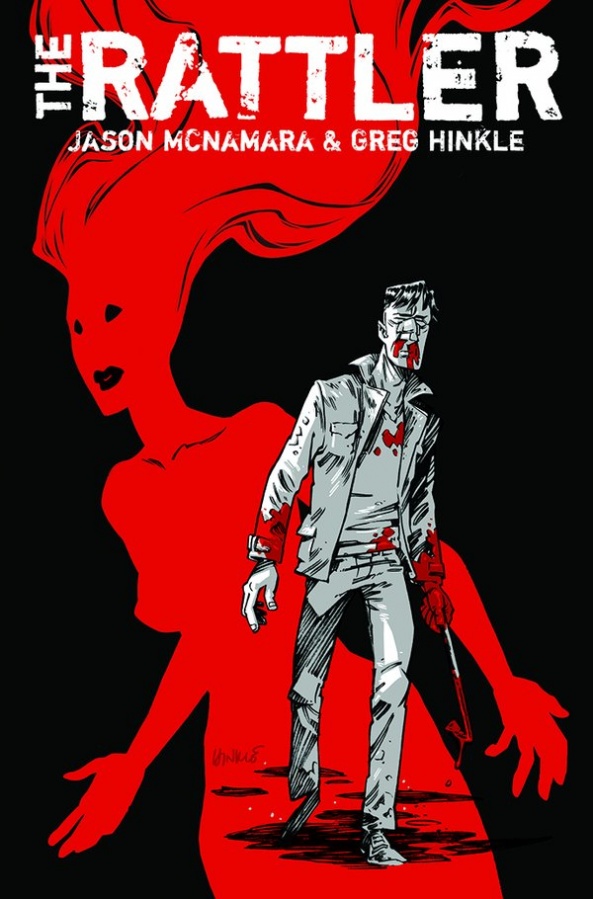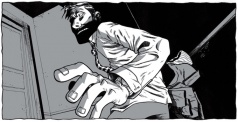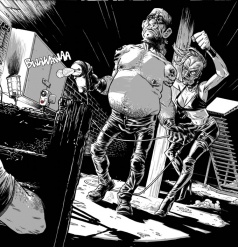
Originally just a successful Kickstarter campaign that produced a well-received graphic novel, “The Rattler” is now coming to Image Comics. Writer Jason McNamara and artist Greg Hinkle tell the story of Stephen Thorn, a man who witnessed his wife get abducted before his very eyes years ago. Since then, Thorn has devoted his life to finding his missing wife and to making life harder for criminals everywhere. When Stephen starts to hear messages from Catherine, his life unravels as he does questionable things in an attempt to find the woman he loves.
Read on as we chat with Jason and Greg about “The Rattler”, the personal inspiration for the story, blood, horror inspirations, and more. “The Rattler” is still available for pre-order until 2/22, so get to your comic shop and request your copy!
“The Rattler” is a book that’s inspired by a personal story for you, Jason. What was that inspiration?
Jason McNamara: Years ago I was on a road trip and a man tried to abduct a friend of mine. It was terrifying, but we were lucky and she was able to get away but the incident stuck with me for obvious reasons. As the ten-year anniversary of that event approached, I was thinking of what witnessing something like that would have done to me. And then I felt guilty because the writer in me was making it my story, which it really wasn’t. And that was the light bulb moment, a young writer who capitalizes on that tragedy to build a career. It was easy to write because in a meta way I’m capitalizing on the near-tragedy of it now.
“The Rattler” was previously funded and published thanks to a successful Kickstarter campaign. How did the book end up at Image? Are there any differences between the KS product and what will be put out through Image?

JM: We wanted “The Rattler” Kickstarter to be an exclusive experience, to that end we didn’t over print the book or make it available to the public. Our backers got their copies early and we offered the remaining copies to the retailers who backed the Kickstarter. The Isotope Comic Lounge in San Francisco, who was a big supporter our campaign, bought our last 70 copies. Then 6 weeks later they called and said they were sold out. And once it was completely sold out, Greg and I started getting messages from people who were looking for a copy. That’s when we realized there might actually be a larger market for “The Rattler”.
Greg Hinkle: Jason and I have both enjoyed the freedom of self publishing, which is what drew us to Kickstarter in the first place. It let us control every aspect of the project. Being able to bring it to Image afforded us the same freedom, so we jumped at the opportunity.
JM: The Image edition will have a new cover and a newly illustrated “deleted scene” that we cut from the script for pacing.
I like that “The Rattler” is black and white, with some grey tones and the only color is red, used when there’s blood on the page. What was the choice behind having the art and colors this way? What do you feel it adds to the book?
GH: The red was a happy accident. I think I was adding the grey tones to a page with a lot of blood on it, and wondered what all that blood would look like in red. It wasn’t until I’d experimented with it a little that I thought seriously about floating it past Jason. He was kind enough to indulge me, and it just kind of snapped into place. We get to a point in the book where there’s a significant amount of red on the page, and for me, it just wouldn’t have had the same impact if the blood had been grey.
JM: Greg’s art, when paired with the grey tones, creates an uneasy soundtrack in my mind. You’re immediately on edge. The use of blood works as a gauge of Stephen’s mental state. We start off with a trickle, and steadily increase the flow as Stephen slips further down into his personal nightmare.
Continued belowThe main character of “The Rattler”, Stephen Thorn, is very set on getting back his wife, who was abducted years before. Even so, he doesn’t seem so much good as determined, as if his wife’s disappearance gives him a reason or excuse to do some questionable things. How did you arrive at that characterization, rather than one that’s more heroic?

JM: Well, for me, flawed characters are just more interesting to explore. Stephen is not a pleasant person; he’s an emotionally unavailable, self-absorbed guy who built an empire exploiting his fiancée’s disappearance. And, like most awful people, he believes he has an excuse to behave the way he does. But when Stephen starts to receive messages from Catherine, with clues to where she might be, that rationale falls apart. The closer he gets to finding Catherine, the more he’s forced to confront what kind of person he really is.
Horror, and getting that genuine creepy feeling across, can be something that’s hard to do in comics. Did the two of you look to any other works as inspiration or look to comics that creeped you out to help get the feel right?
GH: I would look to the older EC “Creepy”/”Eerie” books every so often to try and solve certain problems. Setting plays a big part in horror and suspense (and other genres too, I guess) and establishing shots have always been tough for me. This was my first complete story, so I was looking at everything I could get my hands on for inspiration. I looked at Mike Mignola’s work frequently to study the way he sets a mood. Jason and I are both big fans of Becky Cloonan, and her trilogy of self-published mini-comics was out on my desk for a very long time. Emily Carroll’s horror comics, too.
We’re both pretty big horror movie fans, too, which may have had an even bigger influence on this project than any specific books I can think of. I grew up on a steady diet of ’80s and ’90s horror/thriller movies.
JM: We knew we wanted to go with black and white to help establish tone. I looked at older films like Eyes Without A Face (1960), Psycho (1960) and Repulsion (1965) to help stage scenes and get the most creepiness out of them. The Thing (1982), The Hitcher (1986), The Town That Dreaded Sundown (1976) and Dark Night of the Scarecrow (1981) were also huge influences on me while writing.

While “The Rattler” is very much a self-contained story, the ending leaves things a bit ambiguous. We already know the Kickstarter was successful, but if the book is successful at Image, is there a chance we’ll see more of Stephen and his story?
JM: Greg and I we would jump at the chance to return to this world. We have a lot of options on where we could go next. But I’m not convinced the next story should be about Stephen, I think he needs a little time out for bad behavior. I’d like to expand the world with other characters and maybe check back in Stephen down the road. That’s the pipe dream anyway; we’ll have to see how “The Rattler” goes over first.



